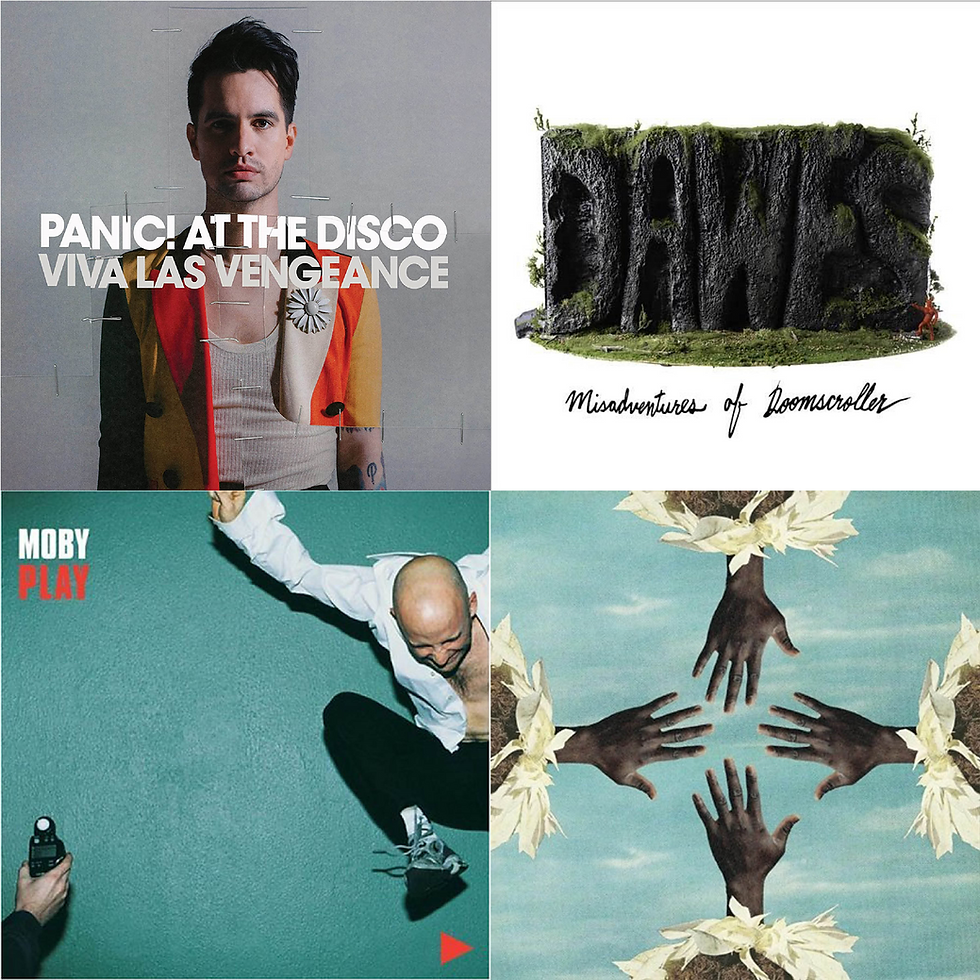ALBUMS WORTH A SPIN: August's Rotation Hogs.
- Neil Rajala
- Aug 28, 2022
- 4 min read

August was a pretty fine month overall, both for new music and old faves. In real life, I landed a new freelance music writing gig that seems promising, and my power-walking routine is putting up stats I wasn’t sure this old body could manage. Here are the records that got the most plays over the last month.
• Panic! At the Disco, Viva Las Vengeance (8/19) – The number of different bands you can hear in Panic!’s new album is head-spinning, exactly what makes it such a sugar rush of fun. “Middle of a Breakup” has a chorus that borrows heavily from fellow Las Vegas-ites the Killers’ superb “Spaceman.” “Star Spangled Banger” has verses that are such a blatant cop from Thin Lizzy’s “The Boys are Back in Town” I double-checked the songwriting credits for Phil Lynott’s name (nope). Occasionally, credit is given where credit’s due. Russ Ballard (Argent) and Eric Carmen are listed as co-songwriters for “God Killed Rock and Roll” and “All by Yourself,” probably because they barely changed the titles of the smash singles they reimagine here.
And then there’s the elephant in the room, Queen. PATD has always borrowed liberally from the band, but on Viva Las Vengeance there’s no attempt to play down their influence. I had the feeling listening to it that singer/songwriter/bandleader Brendon Urie chopped up “Bohemian Rhapsody” into little pieces and sprinkled it liberally throughout the album. The massed chorus vocals, Brian May’s singular guitar tone, it’s all here, popping up when you least, or maybe most, expect it. Urie says Viva Las Vengeance is a tribute to his influences, and it can be quite a rush trying to keep up as they go whizzing by. Probably the best trick PATD pulls off is honoring its heroes while making a modern sounding, glammy, rocking record that comes across as big fun in its own right.
EARWORM: “Middle of a Breakup” – Because the Killers chorus they borrow is such a great one.
• Dawes, Misadventures of Doomscroller (7/22) – Dawes goes prog? Not exactly, but they veer close to it on their eighth studio album. To be honest, I’ve been worried about these guys since 2016’s brilliant We’re All Gonna Die. The two follow-up records, Passwords and Good Luck with Whatever, felt a little formulaic to me. Taylor Goldsmith seemed to be locked into a type of predictable songwriting and vocal phrasing that was starting to sound like a musical dead end. But with Misadventures of Doomscroller, the band tosses out what came before and opens up the playbook in a huge way, just like they did with We’re All Gonna Die. The album opens and closes with tracks that pass the nine-minute mark and feature twists and turns not unlike Steely Dan at their jazziest. That kind of more experimental songwriting and arrangements are all over the album, which also gives Taylor the opportunity to sing in a number of new voices, from the bouncing glide of “Comes in Waves” to the staccato, tumbling “Ghost in the Machine.” Misadventures of Doomscroller sounds fresh and exciting in a way Dawes hasn’t since, well, 2016.
EARWORM: “Ghost in the Machine” – A rollin’ and tumblin’ banger.
• Moby, Play (1999) – It was the announcement of a brand-new vinyl reissue that got me thinking about this one again. I streamed it one night mid-month, and haven’t been able to stop, like it’s 1999 all over again. Moby made Play in his NYC home studio with the plan it would be his last album. It became such a huge surprise hit he changed his mind. Not that it hit right away, it kind of stiffed until Moby started to license songs from it for use in TV shows, commercials, and films. Play’s unique and supremely catchy combination of homemade electronic loops and samples from old blues and gospel records caught viewer’s attention and became part of the turn-of-the-century cultural zeitgeist. After selling about 6000 copies the week it was released, Play was moving about 150,000 units weekly within a year. It sounds just as fun, danceable, and compelling 23 years later. Pop music that holds its own with Brian Eno’s mid-70s output.
EARWORM: “South Side” – One of the few tracks with the artist’s own voice instead of a sample. Terrific hook.
• Kokoroko, Could We Be More (8/5) – Thanks to a long-lost friend’s record collection, and nights drinking way too much dark beer together, I became a fan for life of sub-Saharan African pop and rock music. Not unlike the U.S., the popular music of the 60s and 70s in countries like Angola, Nigeria, Namibia, and Zimbabwe evolved from traditional folk and religious songs. The more commercial records we listened to over and over were joyous, giddily polyrhythmic, and stuck in the brain even though the lyrics were unintelligible.
Kokoroko isn’t from Africa, they’re an eight-piece sprung from the very active “new jazz” scene in London. Trumpeter Sheila Maurice-Grey is at the helm, and although the music fits squarely in the jazz genre, Could We Be More is deeply influenced by the percolating rhythms of central African pop, with a touch of Caribbean lilt thrown in. Kokoroko has mostly a light, but complex approach to their arrangements. Could We Be More works fine as a breezy soundtrack for going about your business, or as a subject for deeper listening if you want to appreciate the deep interplay skills of an exceptional batch of young musicians.
EARWORM: “Dide O” – A song that features the two-finger “highlife’ guitar style of the music I grew to love.




Comments